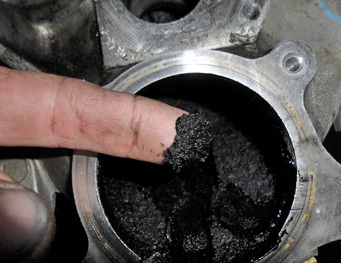烟炱
润滑油中烟炱检测
背景

由于没有发动机的效率是100%的,因此燃烧过程会产生二氧化碳和水以外的产物。不完全燃烧生成的一种产物是烟炱。烟炱主要由碳颗粒组成,通常呈球形。随着烟炱数量的上升,烟炱颗粒开始聚集在一起,变得更加危险。烟炱数量将持续增加,直到达到足以沉淀的水平。这些沉淀物既会增加油的粘度,还会附着在发动机表面,这将显著增加发动机的磨损。这些沉淀物也会导致过滤器堵塞。定期进行烟炱检查可以延长废用周期,减少油品消耗并延长柴油发动机的使用寿命,进而节省成本。
润滑油中烟炱的检测方法
► 固定滤光片红外分析仪
烟炱样品的固定滤光片红外分析是ASTM通过的测试方法(D7686),其正在成为一种更流行的技术。使用特定波长的固定滤光片,分析仪可以确定柴油发动机油中烟炱的含量,最高可达重量的15%。这种方法使用3.9μm的固定滤光片和水平衰减全反射(HATR)晶体进行测量。HATR晶体使清洁变得更加容易。将干净油的样品滴加到HATR晶体上并进行背景测试。从晶体中取出干净的油样,然后将待测的样品均质化,滴加到晶体上并进行测量。在进行检测时要迅速,因为烟炱往往会沉降到晶体上并产生更高的读数
仪器计算样品的吸光度,然后根据内部校准将其转换为浓度读数。如果使用正确,这种方法非常精确,但是如果不先将样品均质化或使样品沉降在晶体上,则会产生较差的结果。总体而言,使用固定滤光片和HATR晶体可以在实验室或现场进行快速,简单并且便宜的检测。
►
光栅红外光谱仪
与FTIR类似,光栅光谱仪测量样品在整个中红外区域透射的光。不同的是,它们使用衍射光栅来分离光,这使得系统没有移动部件,变得坚固耐用,便携且价格低廉。由于光栅光谱仪测量光的范围与FTIR相同,因此它们可用于测量许多与FTIR相同的油品特性。按照ASTM标准D7889,使用4点多变量校准测量柴油发动机油中的烟炱浓度。加权基线还用于最大限度地减少不正确的背景测试和样品特性(如未溶解的水和高TBN)造成的误差。测量样品时,首先要完成空白腔室的背景测试。然后将样品放入腔室中测量。烟炱浓度由仪器软件使用多变量校准进行计算。完整分析所需的时间不到三分钟。
► 热重量分析(TGA)
TGA是烟炱分析的传统方法,也是ASTM(D5967)批准的检测方法。该方法利用热量迫使样品发生反应和产生物理变化,以得到烟炱的定量结果。将样品放入烘箱中,在整个过程中持续监测重量。将样品在烘箱中加热,直到所有有机物质蒸发,只剩下不溶性颗粒。将样品保存在氮气中,防止发生氧化。随后,用氧气代替氮气,加热样品直到烟炱完全燃烧,只剩下无机氧化物。烟炱浓度是通过将引入氧气之前计算的样品重量减去燃烧后样品的重量来确定的。这种方法提供了非常精确的结果(在0.1%以内),但它是一种耗时且劳动密集型的方法。
► FTIR红外光谱仪
FTIR(傅里叶变换红外光谱)是一种ASTM认可的(D7844)现场检测技术,用于监测柴油发动机油中的烟炱水平,既便宜又快速。FTIR光谱仪测量样品在光谱的中红外区域(4000-400 cm-1)透射的所有光。这使得仪器能够测量油的烟炱含量,并测量其他性质,如氧化、硝化、硫化、水和乙二醇含量。该方法的工作原理是首先将干净的油样放入红外池中,然后在光谱仪上对其进行测量以建立基线。将干净的油取出,加入待测油样进行测量。由于该方法测量散射而不是吸收的红外光量,样品与2000 cm-1处的干净的油的基线差异可以确定烟炱含量。这种技术能提供快速又高度可重复的结果,但并不总是能提供良好的精度。因此,FTIR方法最适合在现场进行趋势分析。
总结
有几种方法可用于柴油发动机油中烟炱的实验室和现场分析检测。方法的选择取决于预算,精度,测试地点,时间和其他因素。最重要的是要持续监测柴油发动机油中的烟炱污染,以避免出现意外停机和设备故障。
